“Victorious warriors win first and then go to war, while defeated warriors go to war first and then seek to win.”—Sun Tzu, The Art of War
How do you recruit a growing army of creative young people while destroying and looting some of the world’s most precious art, forbidding instruments in music, and killing people for basic expressive acts like shaving or voting in an election? How do you generate “a still-steady inflow of foreigners, ready to give up everything at home for a shot at paradise in the worst place on Earth”? This despite apparently having few resources, formal allies, or a vision of the future that does not end in apocalypse?
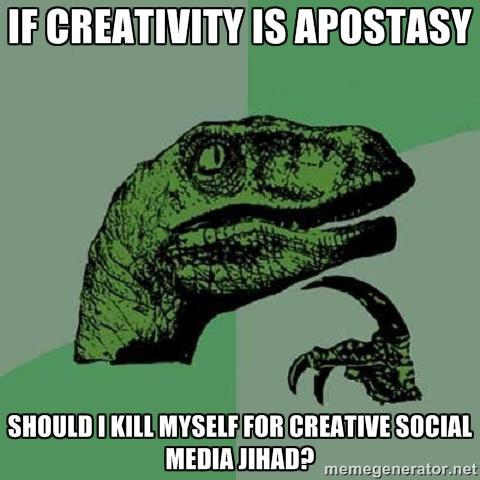
You run a better information game than your opponent. And boy is ISIL—which we’re not calling the Islamic State because it’s not Islamic and it’s not a state—running a better information game than the West. Artists have to step up and solve this problem, because it’s an assault on the human spirit, divine creative experiences, and the freedom of conscience that allows us to create.
ISIL is the Justin Bieber of terror. It sprang up overnight with no warning, a bunch of young idiots love it for no readily apparent reason, and it’s not going away.

In fact, its forces took the Syrian city of Palmyra this week, and it’s driving me crazy.
Probably we have to go to war to defeat ISIL. But to paraphrase Sun Tzu, we want to win before we do that.
Here are ten things artists and other everyday heroes can do to combat ISIL before it succeeds in launching an overt, larger-scale terror attack on U.S. soil. It’s already responsible for domestic attacks including a recent one in Texas that resulted in a few cartoonists’ deaths.
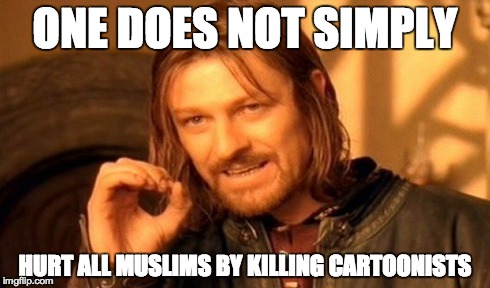
See a problem or something I left off the list? Leave it in the comments. I haven’t talked with anyone about this, so it will be nice to get hive help improving my thinking here.
10 Things Artists Can Do to Fight Terror
All of these things apply the same basic insight that free expression—not bloodshed—best combats abuses of free expression. Each could be a separate post, and maybe will be going forward.
Everything that directly targets ISIL-affiliated accounts should probably be done anonymously via Tor and blind email and social network accounts.
1. Don’t call it combat or fighting terror.
Oops.
When people focus on terrorism, they feel afraid. That’s a victory for terrorists. This is also an extension of a more basic rule of good writing—use positive phrases. Instead of “don’t use negative phrases,” for example. It’s clearer and prettier. That’s Orwell and Strunk & White on good writing.
It also happens to be a better cognitive strategy for directing selective attention to what you want instead of what you don’t, and this matters because attentional resources are limited.
So first we have to be clear about what we’re up to. We set the terms of the discourse. Armies fight terror. Artists tell the truth and celebrate.
When you tell the truth, it enlightens. You get high. And you can help people envision better lives, believe in the goodness in themselves and others, and thus make a better world.
In cognitive psychology, this is a trick of positive selective attention. It often gets a bad wrap in reporting as if it’s disingenuous. But it feels good and can be honest. Think of the power of Harry Potter or Oprah—or reporting on the Peace Corps or successful policing, military, or disaster relief efforts instead of tragic mistakes, abuses, or failures.

Stories of hope make people’s lives better. There’s less attention to the positive realities even though they’re just as real, in part because the primary sources for them can seem interested and thus less credible. After all, a crime victim the police help isn’t likely to go to a reporter with her story rather than getting on with life. And who but the Peace Corps is going to report on Peace Corps success stories? Small operations like Utne Reader and The Sun have long recognized and tried to fill the resultant media gap in stories of hope.
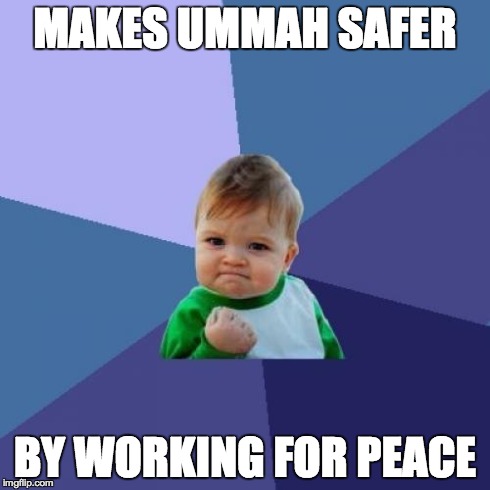
I can do this by traveling the world making art, interviewing people, and writing one of the book projects on this list you should take now to help me pick one.
Maybe I should also start a list of positive media forces to interview, pitch things to, or emulate. For example, I really like (and have published with) the following:
The Science Creative Quarterly
Dissertation Haiku
The Christian Science Monitor
McSweeney’s
Feathertale
2. Offer and Strengthen Alternative Identities.
A lot of ISIL recruits weren’t that religious before finding the group. They were isolated, alienated, and desperate for community, purpose, and a sense of worth.
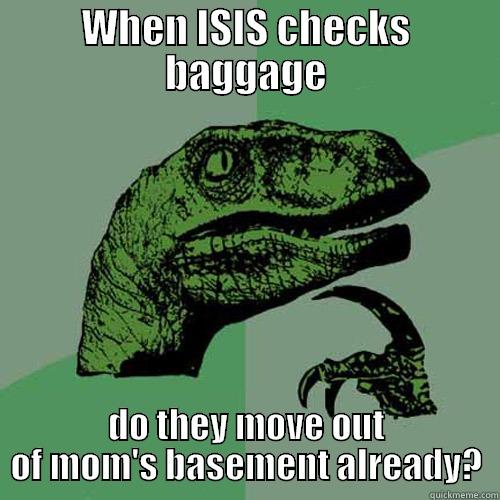
And a lot of the people whose communities they’ve wreaked havoc on are gonna be in a similar position after ISIL is defeated. So stemming the tide of recruits and helping rebuild both require offering and strengthening alternative identities.
Those are exactly the same identities ISIL undermines by destroying precious art, architecture, and artefacts.
But there’s too much richness and beauty in the world for it to be destroyed completely. What remains needs to be celebrated. And maybe God will replace some of what has been lost. You couldn’t ask for a better answer to a movement that destroys art in the name of God than a series of sacred apparitions like Juan Diego’s Lady of Guadalupe, Charles Angrand’s Good Samaritan, or any number of other religious visions celebrated in art.

You don’t have to have a lot of resources to create divine pop-up art. One could imagine creating a simple how-to guide and supplies kit. One might do that on Etsy in the not-too-distant future.
3. Tell the Whole Truth
We tortured. That’s a problem.
Stop. I don’t care what you think about the terms, the context, or other possible justifications. It was illegal, immoral, and didn’t work. Instead it backfired, because security is about trust. Procedural justice research bears out the evidentiary basis for this common-sense logic. Evidence shows that when people trust that police are legitimate, they’re more likely to cooperate and behave in law-abiding ways. When they don’t, they’re less likely to talk to police and follow the rules.
So it’s unsurprising to see direct links between these post-9/11 American detention and interrogation practices, and the development of the Islamic State. Recent revelations linking coercive interrogation practices in domestic police departments with those abroad are probably hurting national security in similar ways.
This is a problem because we have a free press and freedom of speech—the U.S. stands out even among Western peer nations in refusing to outlaw hate speech—and want to shine light on serious problems to make them better. But circulating photos and stories of terrible, uncommon abuses that are not ongoing also provides more fodder for the terror propaganda machine. Even showing photos of the abuses at Abu Ghraib for purposes of denouncing them activates the same negative neuronal networks of anger, distress, and hopelessness as showing the photos for purposes of terror recruitment. Most people’s physiology actually changes after seeing images of threat, which in turn changes what part of your brain you can use to process information. So the threat cues in photos of abuse activate the lizard brain, and fear rules thought below the level of awareness.
So we don’t have to keep talking about the same mistakes, or even hold Congressional hearings into whether crimes were committed. Those moves actually make people feel less safe by drawing selective attention to threat even though the threat (e.g., of post-9/11 torture) is not ongoing. f
But to make the world feel safer to flourish, we have to integrate the trauma of our national mistakes into a coherent narrative in which we’re learning to do better going forward. That integration means making best practices better in policing at home and abroad, doing more community trust-building in domestic and international security. This way the attention is on the improvement and not the mistakes—learning and helping learning instead of punishing and being punished. This so-called growth mindset predicts success across educational, professional, and personal realms.
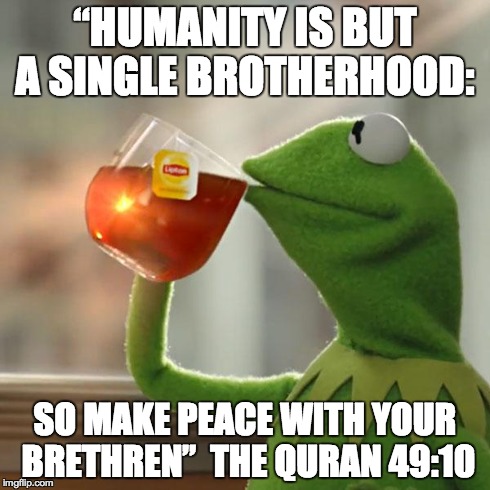
4. Make Better Jokes
At the coolest policing conference ever this winter, I learned three important things:
– ISIL uses memes to recruit home-grown violent extremists, and the law enforcement community doesn’t know what to do about that.
– Memes rhymes with seems! Language is so funny out loud.
– Apparently I seem emotionally distant. No one has ever told me that before in a bar. Because usually no one can get close enough to hit on me.
So there’s a memification of terrorist recruiting using Western logos and funny pictures and stuff on social media. That memification looks like this. Only I’m not posting an image because I’m not spreading the disease. I’m making it a stupid dialogue instead.
Jihad Parrot: Just Dua It!
Loser: Omg, I am totes radicalized.
No really, we have to stop them. They have LOLcats.
Terrorism was already a decentralized problem, but the Internet decentralized it more. The reason terrorism works so well in game theoretical terms is that a big, powerful actor can’t 100% defend against a bunch of weak, decentralized ones. Think Arnold Schwarzenegger in “Kindergarden Cop” surrounded by 500,000 small children.
Arnold cannot defeat the children. Stop. I don’t care how strong he is. That is not the point. They’re kids, he can’t punch them, they’re chaotic, there are too many, and anyway have you ever tried teaching kindergarten?
Arnold has to instead convince the children that he’s a very nice man. This is called soft power.
Memification of counter-terrorism messaging
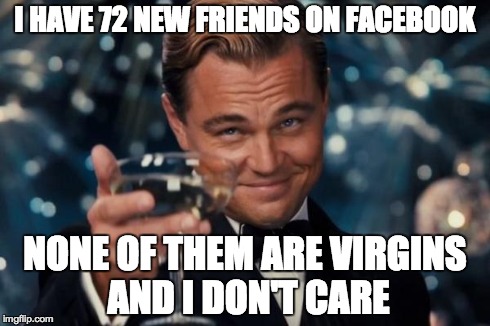
You answer decentralized, funny, values-focused social media messaging with decentralized, funny, values-focused messaging. They use memes; you use memes. They use funny pictures; you use funny pictures. They talk values; you talk values.
This requires honoring your enemy’s anger, which can be a very hard thing to do. It requires a form of forgiveness.
Memification of counter-terrorism does NOT look like:
– Drawing pictures of the Prophet Mohammed, peace be upon him (dishonors enemy’s anger)
– Lobbying Congress to hire a bunch more people who specialize in Facebook (social media is so new that most people and companies claiming to specialize in it have no idea what they’re doing)
– Trying to put memes back in the box (you can’t put information back in the box)
It DOES look like:
– Setting ground rules (see above) to create a safe discursive space for free competition in the game of the responsive messaging. To control the rules of the space to make boundaries where there are none, you have to use carrots not sticks. For example, I could run a contest where the most effective counter-terrorism meme got its own Zazzle store and you’d make money from that. Or we could just, you know, agree to not get ourselves or other people killed. Whatever floats your boat.
– Asking and answering the tough emotional questions before making a discursive move. Those questions are: What am I feeling? What is my opponent feeling? How can I accept both those facts without judgment and honor them?
– Assuming people are good and so fronting values is always both correct and good strategy.
That’s conceptual. The to-do list of a better memification of counter-terror looks something like this:
– Make a public list of popular ISIL recruiting accounts and websites (e.g., Anjem Choudary, Abu Baraa, and Abdul Muhid on Twitter).
– Make another public list of methods of searching for such accounts and websites.
– Put a meme generator by those lists.
– Link in a meme bank so there’s a growing repository of relevant alternate memes.
Don’t make the mistake of assuming someone is already running this ship. Congress is wondering why no one is already running this ship. NO ONE IS ALREADY DOING THIS TOTALLY OBVIOUS AND REALLY IMPORTANT THING TO DO. OMG. WTF? LOL.
Once those lists exist in a public place, it’s easier for everyone to find them—ISIL opponents and sympathizers alike. That’s a problem if the accounts stay active. But one might also make it harder to maintain the accounts through DDOS.
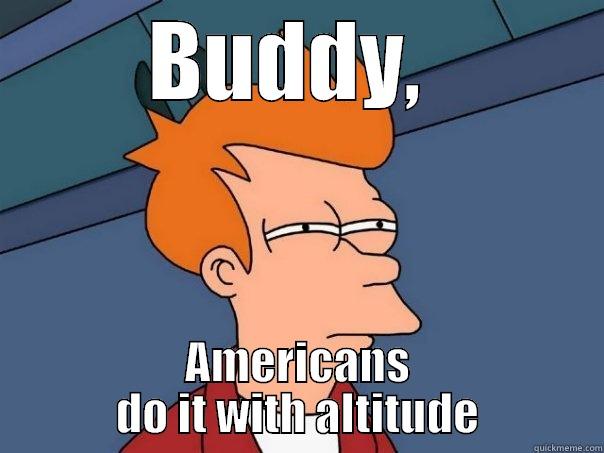
5. DDOS ISIL Recruitment and Propaganda Accounts
DDOS, or direct denial of service attacks, are an established form of peaceful protest—but they’re still illegal.
Here’s how someone else says a person might execute a DDOS attack without getting caught if you wanted to, but I don’t really know how to do it and you shouldn’t because it’s illegal.
Note that the known ISIL recruiting/propagandizing accounts are still up even though people seem to think the security state is all-powerful and disregards the law. The accounts are still up because the police and national security agencies are tightly constrained in what they can and can’t do, especially when it comes to media. And they’re law-abiding. Otherwise, rest assured they would have taken these suckers offline a long time ago.
Sure, some of it is probably intelligence-gathering—leaving validated information sources up to listen in. But contrary to what a lot of people make of revelations about mass surveillance from document dumps like Edward Snowden’s—which was so big even he didn’t read all the documents he leaked—the Internet is actually too big to surveil.
There is no man behind the curtain. There’s just you and me, and all our friends. And the trolls who apparently have nothing better to do. And some NSA wankers who can’t handle this ISIL shit because the Internet is too big to surveil. But apparently they can look at your dick pics. Sleep tight.
6. Make Better Terrorist Propaganda Magazines
Make a better Dabiq, the ISIL propaganda magazine—reach your target audience with alternative narratives immediately.
7. Make Better Images from the Frontlines
This requires embedding with volunteer forces like some U.S. veterans with combat experience who have traveled to Iraq to help anti-ISIL militias there.
There’s a reason ISIL has recently targeted journalists and especially photojournalists in the region. And without Western ground troops for reporters to embed with, or civil stability to enable grassroots reporting, it’s hard to create an alternate narrative of what’s going on. So this gives ISIL a monopoly on the image war, which is a default win.
8. Support Volunteer Fighters
I’m not sure how to safely bolster support for volunteer forces. Because if you compile a list of names and locations for donations, it can be used as a target list too. But I’m sure there’s a way to do this that doesn’t jeopardize safety.
9. Support Public Art
It may seem frivolous when everything else is insecure, but art gives people hope—and freedom of expression helps us reclaim public spaces that have been marred by violence. So it seems important to support public art around the world. I’m sure there’s a way to do this that also measures art’s effects, maybe even testing how different forms of celebrating faith, peace, and freedom affect people’s well-being, sense of safety, and even perhaps the willingness to cooperate with law enforcement that in turn helps make communities safer.
Doing this at home and abroad at once also serves to underscore the common humanity that underpins peace and resilience.
10. Stop Calling them Amateurs and Paperclip their Propagandists
This is an elitist response to a populist problem. But probably a lot of ISIL recruits change their minds once they see how bodies on the ground don’t really smell of myrrh and roses. It’s a problem helping these people get out without getting killed. We can’t exactly resettle them in Peoria.
But we can resettle their propagandists, the information scientists who are probably running their show behind the scenes. We did it with Nazis, the so-called Paperclip Scientists. And we might as well do it sooner rather than later with these guys to take them out of action.
Because ISIL looks grassroots, but actually has high production values. Look at an ordinary, good quality Youtube cover video. Now look at an ordinary, good quality ISIL video. CNN marks it “amateur video.” But there’s nothing amateur about it. There’s panning without shaking on uneven ground. I couldn’t do that. Someone probably has a tripod or a fig-rig to pull that off. If you can find a version with audio, it’s better than it should be for being outside under windy conditions with noise from multiple directions as recorded by a phone. Someone probably bothered with a lav mic in a war zone. Who does that?
Professionals do that. The grassroots appearance is part of the messaging, like it is with a lot of apparent overnight successes in the music industry and other businesses. But the professionalized administration behind it is part of the same old song and dance including Baathists in Iraq and the Assad regime in Syria. This isn’t new and I’m not the first person to notice this. It’s just really scary and sad, because it means creative tools that can be used to put more light and joy into the world are instead being used to organize and celebrate prejudice and violence.
And that’s not very social at all.